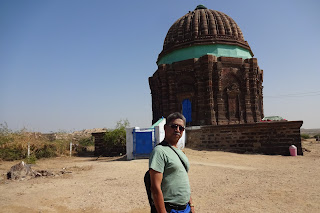Our Gujarat Tour Report ....continued
On the second day
of our stay in Great Rann of Kutch, we visited Lakhpat Fort in the northwest corner of Kutch. (On the way, we
stopped at Mata No Madh temple, a
‘puranic’ temple for Devi. The temple has a story similar to what people talk
about Kamakhya temple in Guwahati, Chandi Mandir near Chandigarh, and
Jwalamukhi in Himachal)
I understand Lakhpat was once a
famous port city, but now virtually abandoned for more than 2 centuries. It
appears that during the earthquake in 1819 the course of Indus River altered to
the West, drying up the Great Rann including Lakhpat. In 1801, Jamadar Fateh
Muhammad had constructed a 7 kilometers long high walls which still remains
intact. We had a long drive to the Fort, but once we were there, climbing the
wall of the Fort and looking beyond the dried up sea we realized that the trip
was worth the trouble.
Lakhpat is also important for Sikhs, as Gurunanak, the
founder of Sikhism had camped at this place on his way to Mecca. There is a
quiet Gurudwara, and here, we enjoyed their traditional free ‘langar’ –
chapathi and tasty ‘dal’. Sikhs are known for their hospitality and feeding all
in their Gurudwaras.
Besides, Phir Gaus Muhammad, a Sufi mystic, had practiced
spiritualism from his age twelve, half as a Hindu and half as a Muslim in
Lakhpat. There is a stone tomb with very complex carvings for him. A water tank
adjacent to the tomb is reported to be having miraculous healing powers.
However, the tank looked very dirty and not maintained properly.
Narayan
Sarovar and Koteshwar
From there, we
had another long drive to Narayan Sarovar and Koteshwar.
Narayan Sarovar
appears to be one of the important holy lakes of northern India like Pushkar in
Ajmere. This lake too was full of algae, not maintained properly, and dirty.
The Narayan temple was closed during the time of our visit and so, we drove to
Koteshewar which was nearby.
The temple of Shri Koteshwar Mahadev
sits on the seashore, and the scene looked very similar to Kanyakumari.
All you
see is the vast expanse of deep blue seawater of the Arabic Sea. The Koteshwar
temple looked majestic with its tall, beautifully carved temple towers. There
is a long pier jetting into the sea for small naval boats and ships.




































































